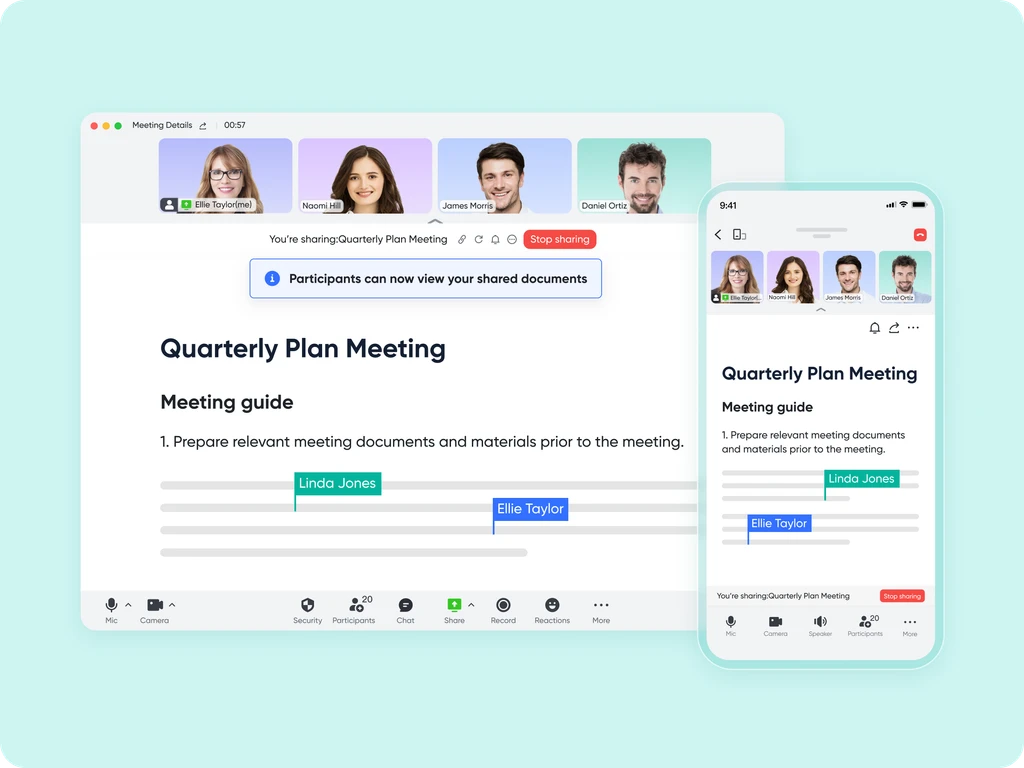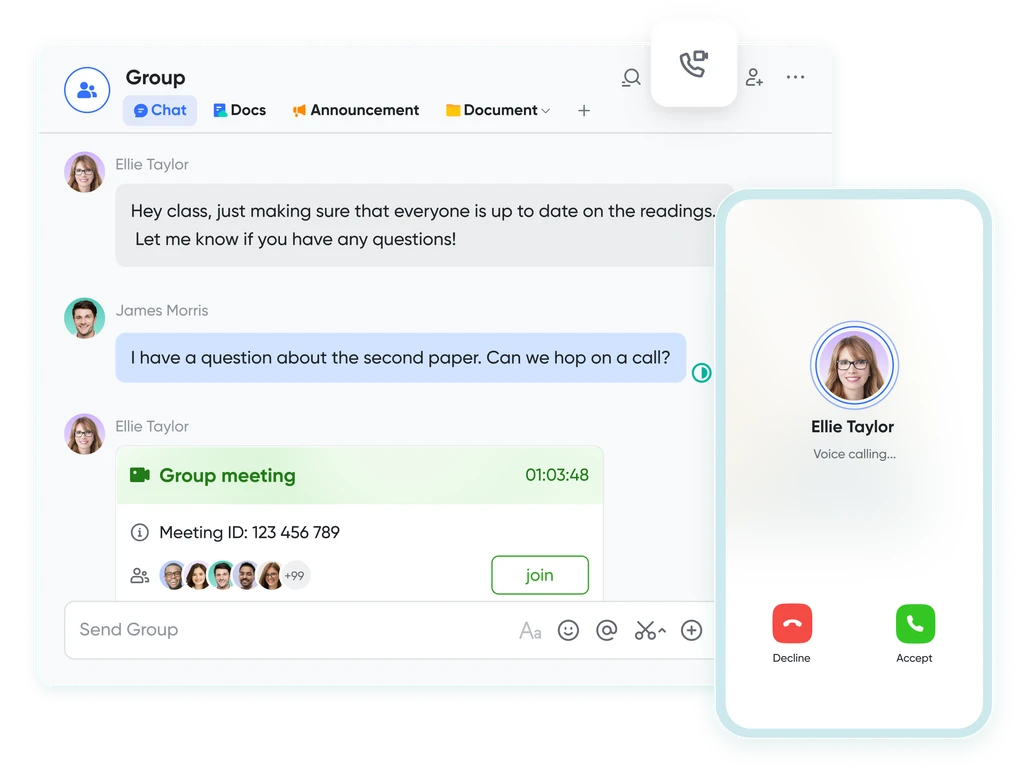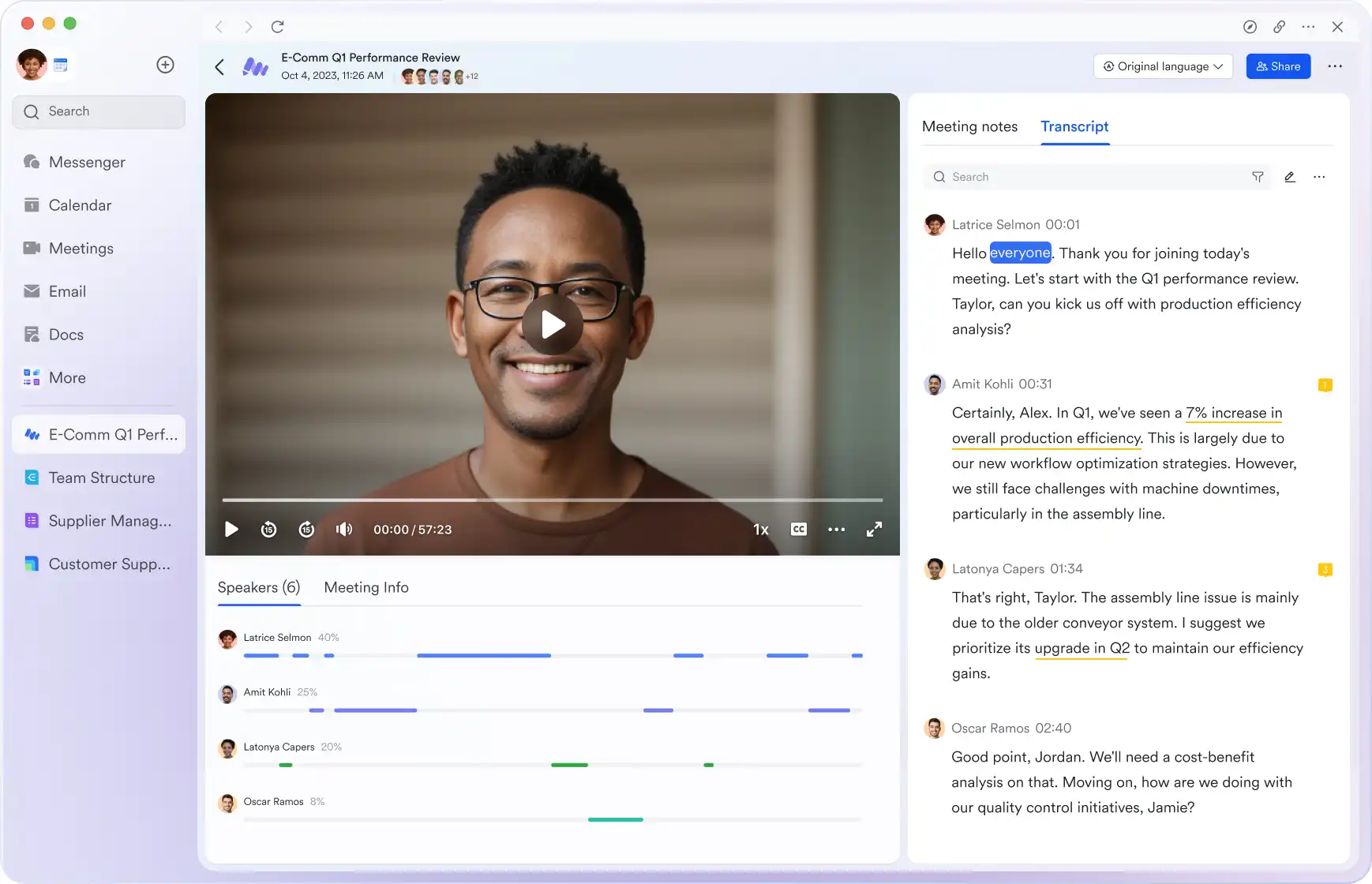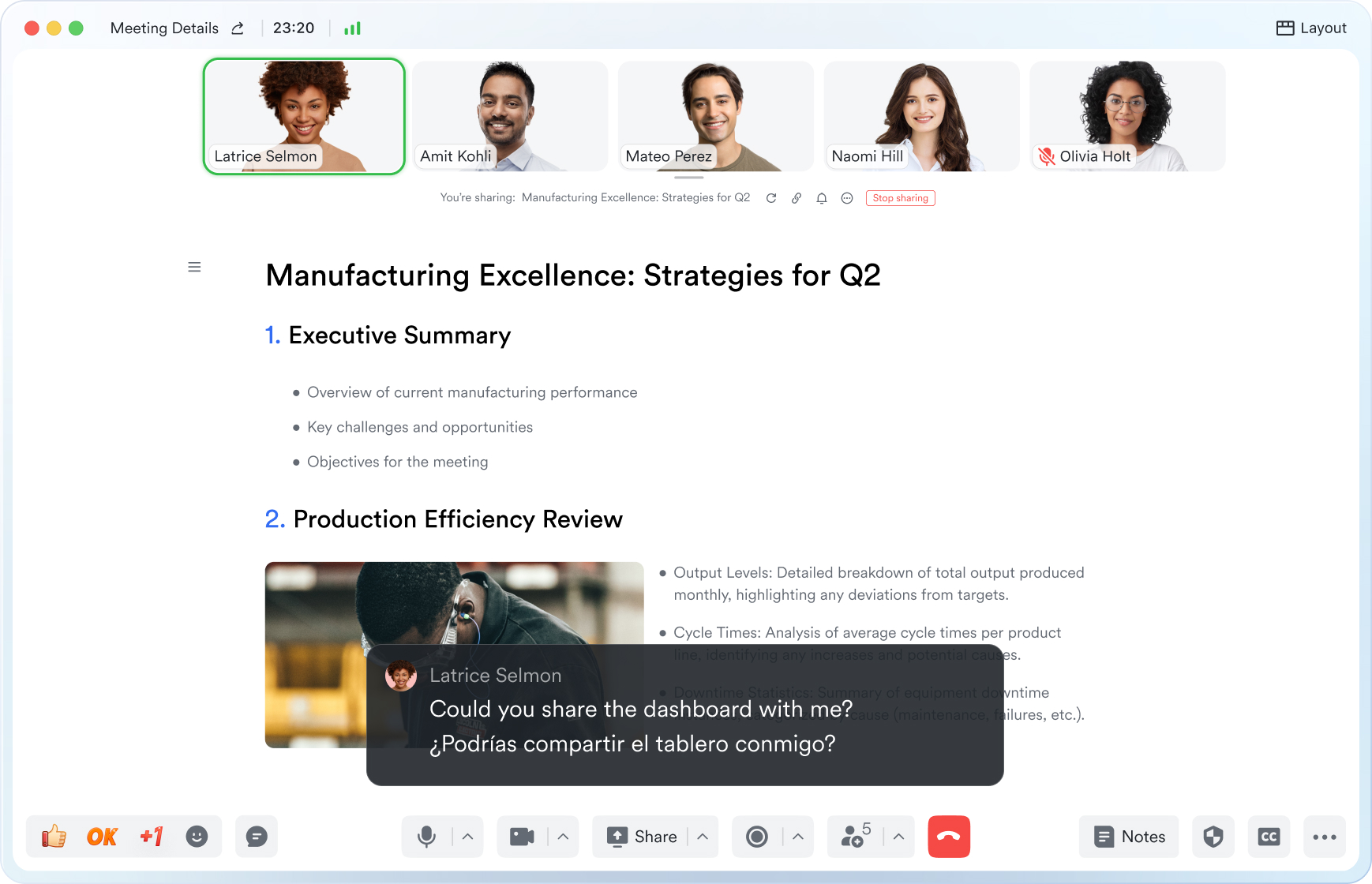Project Management Meeting
This guide will walk you through the essential elements of use project management meeting to keep your attendees aligned and engaged.
Try Lark for Free
Project management meetings are essential gatherings in the realm of project execution and oversight. These meetings play a pivotal role in planning, tracking progress, and ensuring the successful delivery of projects within the defined scope, timeline, and budget. In this comprehensive guide, we'll delve into the significance of project management meetings, how to conduct them effectively, and best practices for optimizing project outcomes.
Use Lark Meetings to turn meetings into true collaborative experiences.
What is a project management meeting?
Orchestrating Project Success
A project management meeting is a structured and purposeful gathering of project stakeholders, including team members, managers, and clients, to discuss, assess, and manage various aspects of a project. These meetings serve as a central hub for project-related discussions, decision-making, and problem-solving.
Goals of project management meetings
Strategic Project Alignment
The primary goals of project management meetings include:
- Project Status Updates: Reviewing the current state of the project, including milestones, timelines, and deliverables.
- Issue Identification: Identifying challenges, roadblocks, or risks that may impact project progress.
- Decision-Making: Making critical decisions related to scope, resources, and project adjustments.
- Communication: Ensuring effective communication among project stakeholders and alignment with project objectives.
Who should attend project management meetings?
Key Participants
Project management meetings involve a diverse group of individuals who contribute to the project's success. Key participants typically include:
- Project Manager: The individual responsible for overall project planning, execution, and oversight.
- Project Team Members: Individuals actively working on project tasks and deliverables.
- Clients or Stakeholders: External parties with a vested interest in the project's outcome.
- Subject-Matter Experts: Experts or specialists who provide insights and guidance in specific project areas.
Related:
Unlock the Power of Webinars: A Comprehensive Guide to Boost Your Business | Lark Blog | Lark BlogLearn more about Lark x Meetings
Topics, agenda, and structure of project management meetings
Structuring the Meeting
An effective project management meeting follows a structured agenda and format, encompassing various components:
- Agenda Review: Begin the meeting by reviewing the agenda and objectives to set the tone.
- Project Status Updates: Each team member provides updates on their tasks, including progress, challenges, and anticipated timelines.
- Issue Identification: Identify any project-related issues, risks, or roadblocks that require attention.
- Discussion and Decision-Making: Engage in discussions to resolve issues, make decisions, and address project adjustments.
- Resource Allocation: Discuss resource allocation and ensure alignment with project needs.
- Client or Stakeholder Input: Gather input from clients or stakeholders regarding project direction and expectations.
- Action Item Assignment: Assign action items, responsibilities, and timelines for follow-up tasks.
- Timeline and Milestone Review: Review project timelines, milestones, and upcoming deadlines.
- Budget and Resource Tracking: Monitor project budget and resource utilization.
- Documentation: Maintain thorough records of meeting discussions, decisions, and action items.
How to conduct an effective project management meeting?
Step-by-Step Guide
Conducting an effective project management meeting requires careful planning and execution. Follow these steps for successful project management meetings:
- Preparation: Define the meeting's objectives, create an agenda, and invite relevant participants.
- Agenda Distribution: Share the meeting agenda in advance to allow participants to prepare and contribute effectively.
- Meeting Facilitation: Appoint a skilled facilitator, typically the project manager, to guide the meeting, maintain focus, and manage time.
- Status Updates: Begin the meeting with individual status updates, with each team member sharing progress and highlighting any issues.
- Issue Resolution: Collaboratively address identified issues, leveraging the expertise of subject-matter experts if needed.
- Decision-Making: Make project-related decisions by evaluating options, considering impacts, and reaching a consensus.
- Resource Allocation: Ensure that resources are allocated appropriately to support project tasks and objectives.
- Client or Stakeholder Engagement: Involve clients or stakeholders in discussions and gather their input on project matters.
- Action Items: Clearly define action items, assign responsibilities, and set timelines for follow-up tasks.
- Timeline and Budget Review: Review project timelines, milestones, and budget to assess alignment with project goals.
- Documentation: Maintain detailed meeting minutes, including decisions, action items, and responsibilities.
- Follow-Up: After the meeting, communicate action items, monitor progress, and provide updates as necessary.
Related:
Master the Art of Meeting Notes with Lark for Enhanced Collaboration | Lark Blog | Lark BlogLearn more about Lark x Meetings
How often should you hold project management meetings?
Meeting Frequency
The frequency of project management meetings varies depending on project complexity, size, and duration. Commonly, project management meetings occur regularly throughout the project lifecycle. Early project stages may require more frequent meetings, while later stages may shift to weekly or biweekly gatherings. The key is to maintain a schedule that ensures effective project oversight without overwhelming participants with excessive meetings.
Key differences between project management meetings and similar meetings
Understanding Distinctions
Project management meetings have unique characteristics that differentiate them from other types of meetings:
- Project Focus: These meetings revolve around project planning, execution, and oversight.
- Diverse Participation: They involve a wide range of participants, including team members, managers, clients, and subject-matter experts.
- Structured Agenda: Project management meetings follow a structured agenda that includes status updates, issue identification, and decision-making.
Learn more about Lark x Meetings
Common pitfalls of project management meetings
Avoiding Mistakes
To ensure the success of project management meetings, be cautious of these common pitfalls:
- Lack of Preparation: Holding meetings without a clear agenda or objectives.
- Ineffective Facilitation: Poor meeting facilitation that leads to disorganized discussions.
- Neglecting Action Items: Identifying issues or decisions without assigning responsibilities or timelines.
- Overwhelming Detail: Drowning participants in excessive project details without focusing on key priorities.
Tips for maximizing the impact of project management meetings
Enhancing Project Success
To maximize the impact of project management meetings, consider implementing these tips:
- Clear Objectives: Define clear meeting objectives and communicate them to participants.
- Structured Agenda: Develop a well-structured agenda that covers essential project aspects.
- Effective Facilitation: Ensure the meeting is efficiently facilitated, maintaining focus and engagement.
- Action-Oriented: Assign and track action items, holding participants accountable for follow-up tasks.
- Client or Stakeholder Engagement: Actively involve clients or stakeholders to align project outcomes with expectations.
Learn more about Lark x Meetings
Examples
Real-world scenarios
Real-world scenarios
Let's explore three real-world scenarios of effective project management meetings in different contexts:
Scenario 1: Software Development Project Management Meeting
Brief Content: A software development project manager conducts a weekly project management meeting to oversee progress, address issues, and ensure alignment with the project's objectives.
Detailed Content: The project management meeting begins with the project manager welcoming the team and reviewing the meeting agenda. Each team member provides updates on their respective tasks, highlighting completed work, ongoing efforts, and challenges faced. During the meeting, an issue related to a critical software bug is raised. The team discusses potential solutions, assigns responsibilities for resolving the bug, and sets a timeline for resolution. The project manager reviews the project timeline, ensuring alignment with the overall project plan. Client representatives also attend the meeting to provide feedback and discuss project priorities. Action items, including bug resolution and feature development, are assigned, and responsibilities are clarified. The meeting concludes with a summary of key decisions and next steps.
**Scenario
2: Construction Project Management Meeting**
Brief Content: A construction project manager holds a biweekly project management meeting to oversee the construction of a new commercial building.
Detailed Content: The project management meeting begins with a safety briefing and a review of the project's safety protocols. Each project team, including architects, engineers, and contractors, provides updates on their respective areas. Team members discuss progress on construction milestones, such as foundation work and structural framing. During the meeting, an issue related to material delays is raised, potentially impacting the project's timeline. The project manager facilitates a discussion to explore alternative suppliers and expedited shipping options to mitigate the delay's impact. Budgetary concerns are also addressed, and resource allocation adjustments are made to stay within budget constraints. Meeting minutes are meticulously documented, and action items are assigned to ensure timely resolution of identified issues. The meeting concludes with a renewed commitment to project safety, quality, and timeliness.
Scenario 3: Marketing Campaign Project Management Meeting
Brief Content: A marketing project manager conducts a monthly project management meeting to review progress on a year-long marketing campaign.
Detailed Content: The project management meeting commences with the marketing project manager welcoming the team and reviewing the campaign's strategic objectives. Team members from different marketing functions provide updates on their contributions, including content creation, digital advertising, and social media engagement. During the meeting, a challenge related to declining social media engagement is discussed. The team brainstorms solutions, including targeted content strategies and influencer collaborations, to revitalize engagement. The project manager reviews the campaign's budget and resource allocation, ensuring alignment with the campaign's goals. Client representatives attend the meeting to provide feedback and insights. Action items, such as content revisions and performance analysis, are assigned, and timelines are established. The meeting ends with a summary of key decisions and a focus on achieving the campaign's long-term objectives.
Tips for do's and don'ts
Best Practices and Pitfalls to Avoid
To ensure productive and effective project management meetings, follow these do's and don'ts:
| Do's | Don'ts |
|---|---|
| Define clear meeting objectives and communicate them to participants. | Don't hold meetings without a clear agenda or objectives. |
| Develop a structured agenda that covers essential project aspects. | Avoid disorganized or unstructured meetings. |
| Efficiently facilitate the meeting, maintaining focus and engagement. | Neglect to assign and track action items, leaving issues unresolved. |
| Assign responsibilities and timelines for follow-up tasks, holding participants accountable. | Overwhelm participants with excessive project details that are not relevant to the meeting's objectives. |
| Actively involve clients or stakeholders to align project outcomes with expectations. | Don't neglect client or stakeholder engagement or communication. |
Use Lark Meetings to turn meetings into true collaborative experiences.
A Game Changer for Project Management Meeting: Empower your team with Lark Meetings
In the fast-paced and dynamic world of modern business, effective communication and collaboration are crucial for success of Project Management Meeting. Here we introduce Lark Meetings to serve as a centralized hub for all communication needs.
Transform your meetings into collaborative endeavors

Leverage the potency of in-call document sharing, intelligent meeting minutes, and mobile-optimized features to enhance productivity collaboratively, irrespective of your location or schedule.
Seamlessly collaborate in real-time, across any device

Share live documents instead of just screen views. Participants can navigate and edit simultaneously within the video call window, even while on the move.
Shift your focus to engagement, not note-taking

Lark Minutes automatically converts video meetings into transcripts, facilitating easy viewing, searching, and collaborative editing. Stay in the loop asynchronously, even if you can't attend the live meeting. Lark Minutes for meeting minutes support translation into 10+ different languages.
Break language barriers in communication

Lark Meetings provide real-time translation for subtitles, allowing individuals from diverse backgrounds to express themselves in their native languages. Ensure every voice is heard, regardless of geographical location. Live subtitles currently support translations from English, Chinese, and Japanese to 10+ different languages. See more translation feature in Lark.
Connect with larger audiences
Host dynamic online meetings and events accommodating up to 1,000 participants, with the flexibility of up to 50 breakout sessions for intimate group discussions within the larger meeting context. Try more Lark features for free.








